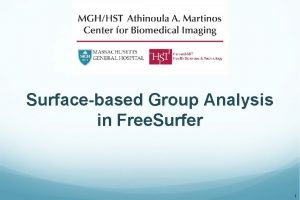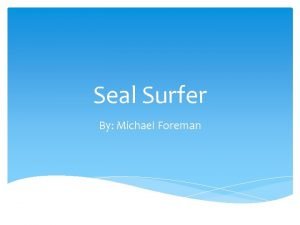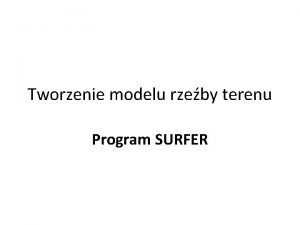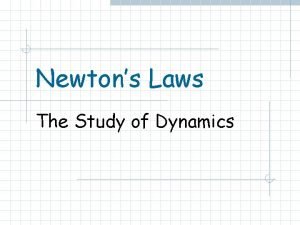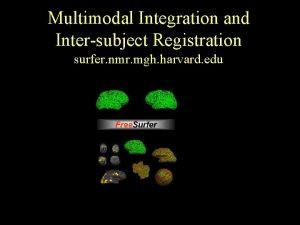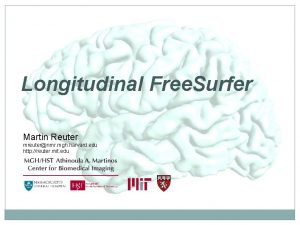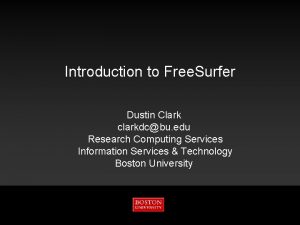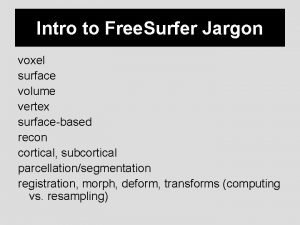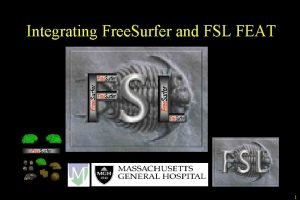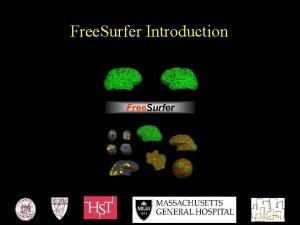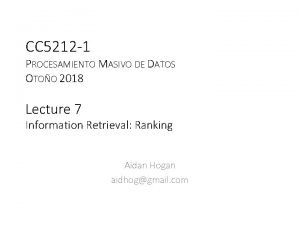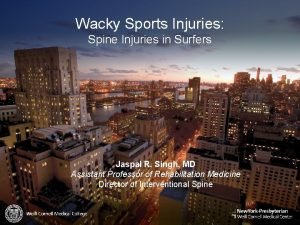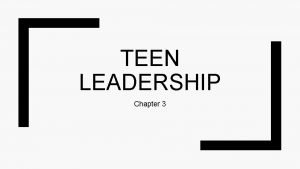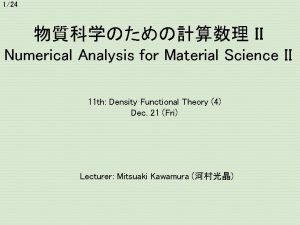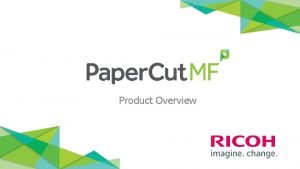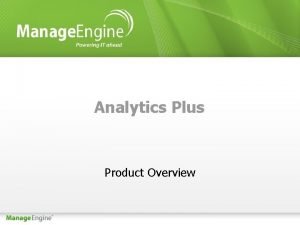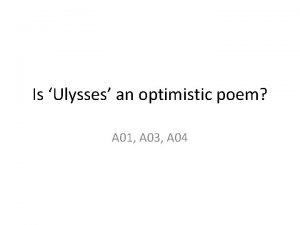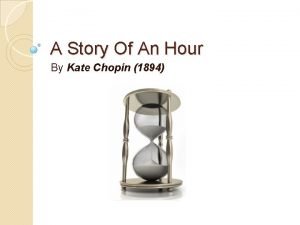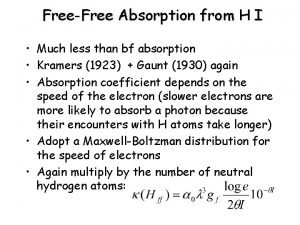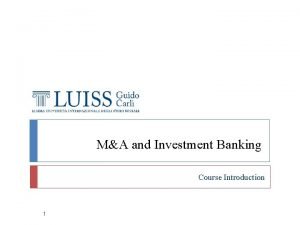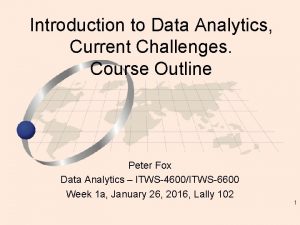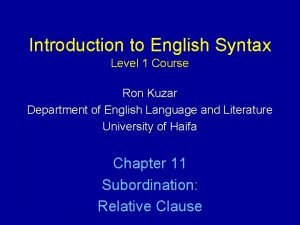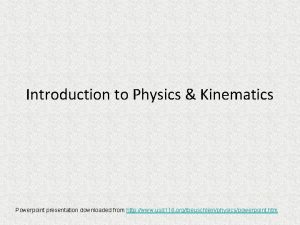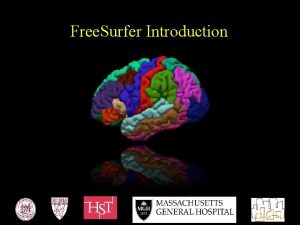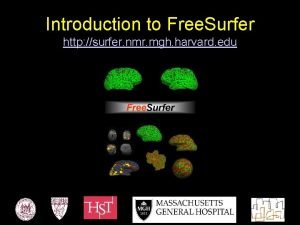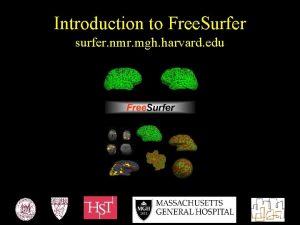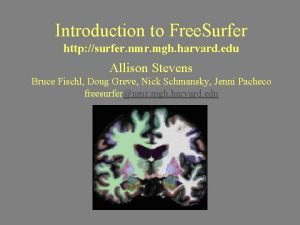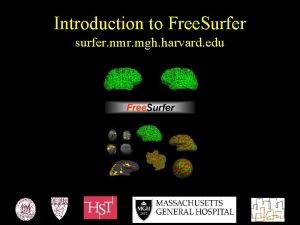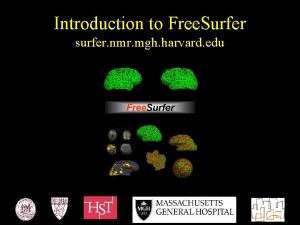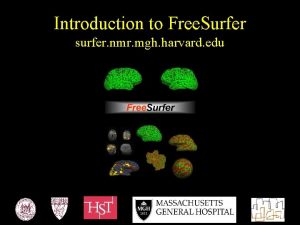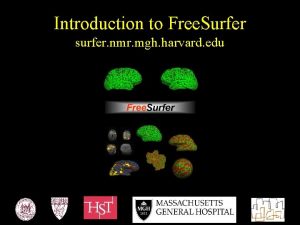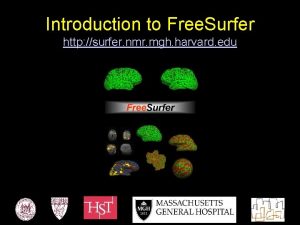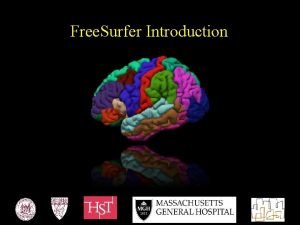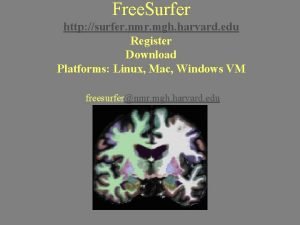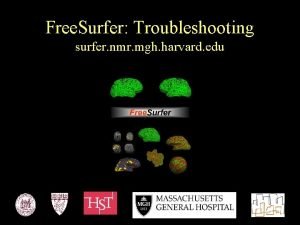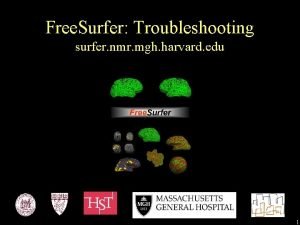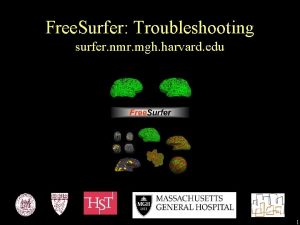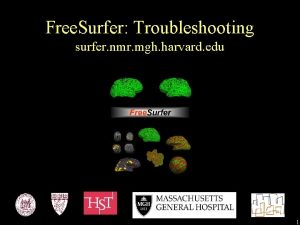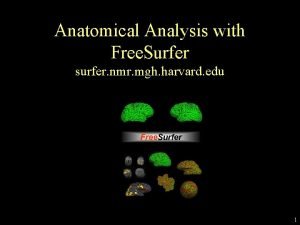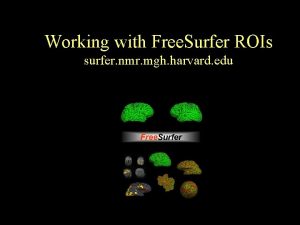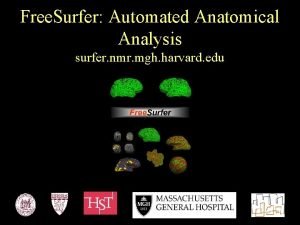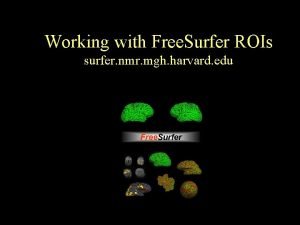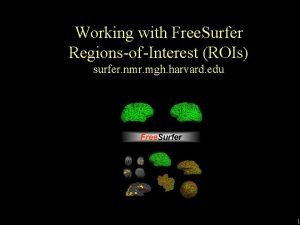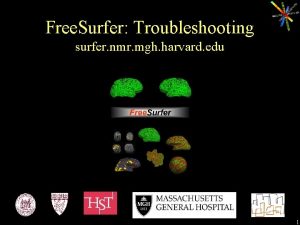Free Surfer Introduction Course Overview Day 1 Day

















































- Slides: 49

Free. Surfer Introduction

Course Overview Day 1 Day 2 – Introduction – Group Analysis – Individual Subject – OCT Analysis – Diffusion Introduction – Surface-based Analysis – Diffusion Tractography – Troubleshooting – Multimodal Analysis – Fibre. Atlas Project – Ex-vivo and Histology

Course Schedule https: //surfer. nmr. mgh. harvard. edu/fswiki/Fs. Tutorial/Tours. May 2016 Course. Schedule

Course Schedule http: //freesurfer 2016. sciencesconf. org/

Lectures and Practicals • General format: talk followed by tutorial (both are on the wiki course page, but please don’t download tutorial data or Free. Surfer– it can kill the network) Search on You. Tube for the Free. Surfer channel!

To Caffeinate or not to Caffeinate? Please don’t spill coffee (or anything else!) on your computers. If you do, please be prepared to fund a replacement!

Post Your Questions! http: //surfer. nmr. mgh. harvard. edu/cgi-bin/fsurfer/questions. cgi

Search for Answers

The Free. Surfer Team 9

The Free. Surfer Team freesurfer@nmr. mgh. harvard. edu 10

The Free. Surfer Team freesurfer@nmr. mgh. harvard. edu 11

What is Free. Surfer? • Neuroimaging analysis software package • Open Source • Detailed characterization of anatomy • Cortex – thickness, folding patterns, ROIs • Subcortical – structure boundaries • Hippocampal subfields • Longitudinal analysis – detect changes • Statistical tools (GLM, LME, …), group comparison • Multi-modal integration • f. MRI (task, rest, retinotopy) • DWI Tractography • PET

What is Free. Surfer? … popular. . . Total # licenses distributed to date: 24, 107

What is Free. Surfer? … social. . . https: //www. facebook. com/Free. Surfer. MRI Facebook, Twitter, Linked. In

Outline • Anatomical Analysis • Surface-based (Cortex) • Volume-based • Multi-modal integration • DWI/Tractography • f. MRI

Outline • Anatomical Analysis • Surface-based (Cortex) • Volume-based • Multi-modal integration • DWI/Tractography • f. MRI

Cortex • • • Outer layer of gray matter 1 -5 mm thick Highly folded 2 Dimensional, embedded in 3 D Function follows the surface • Visualization • Spatial Smoothing • Inter-subject Registration 12

2 D Surface in 3 D Space Inflation Flattening

Surface Model • • Triangle Mesh (“Finite Element”) Vertex = point of triangles Neighborhood XYZ at each vertex Triangles/Faces ~ 300, 000 Area, Distance Curvature, Thickness Movable

Cortical Thickness pial surface • Shortest distance between white and pial surfaces. • 1 -5 mm in healthy subjects

Function Follows the Surface • Visual areas mapped using f. MRI retinotopy • Pattern is clear on the surface, but lost in the volume From (Sereno et al, 1995, Science).

What Can One Do With A Surface Model? goal: use model to imposed desired activity pattern on V 1 desired shape of activity pattern required shape of stimulus w=k log(z+a) left primary visual cortex right visual hemifield Collaboration with Jon Polimeni and Larry Wald.

Tangential Resolution Measured with Surface-based Analysis Collaboration with Jon Polimeni and Larry Wald. Polimeni, et al, 2010, NI.

Tangential Resolution Measured with Surface-based Analysis Collaboration with Jon Polimeni and Larry Wald. Polimeni, et al, 2010, NI.

Neuro. Marketing! Aim 1 of our NCRR Center Grant, spelling: “MGH Center for Functional Neuroimaging Technologies; and NCRR Center for Research Resources. ” (just kidding) Thanks to Larry Wald for this slide.

A Surface-Based Registration Common space for group analysis (like Talairach) “fsaverage”

Anatomical Study: Aging Salat, et al, 2004, Cerebral Cortex

Surface-based Registration Performance Brodmann, 1909

Predicting Brodmann Areas: Talairach Coordinates 10 subjects overlap 1 subject overlap BA 17 (V 1) BA 18 (V 2) (Amunts et al, 2000, 2004) BA 44 (Broca’s) BA 45 (Broca’s)

Predicting Brodmann Areas from Folding Patterns BA 17 (V 1) 0% BA 44 BA 18 (V 2) 100% Overlap BA 45 Fischl, et al, 2007. Thanks to Katrin Amunts, Karl Zilles and Hartmut Mohlberg for the data, and to Niranjini Rajendran and Evelina Busa for the analysis.

Automatic Gyral Segmentation Precentral Gyrus Superior Temporal Gyrus Postcentral Gyrus Based on individual’s folding pattern

Outline • Anatomical Analysis • Surface-based (Cortex) • Volume-based • Multi-modal integration • DWI/Tractography • f. MRI

Volumetric Segmentation (aseg) Cortex White Matter Lateral Ventricle Thalamus Caudate Pallidum Hippocampus Not Shown: Nucleus Accumbens Cerebellum Putamen Amygdala

ROI Volume Study Lateral Ventricular Volume (Percent of Brain) Healthy MCI: Did NOT convert MCI: Did convert Probable AD AAA Fischl, et al, 2002, Neuron 25

Combined Segmentation aparc+aseg aparc aseg wmparc Nearest Cortical Label to point in White Matter

Ex vivo MRI of hippocampal subfields Resolution as high as 0. 1 mm isotropic Allows precise manual tracing of hippocampal subfields. The delineation only relies on geometry for subdividing the CA. Joint work with J. Eugenio Iglesias, Koen van Leemput and Jean Augustinack

Automated Segmentation We use the atlas as a prior, and connect it to the image through a Gaussian likelihood term for each label. This makes the segmentation sequence-independent. 0. 6 mm isotropic T 1 (Winterburn et al. ) 1 mm T 1 + 0. 4 x 2 mm T 2 (ADNI) Joint work with J. Eugenio Iglesias, Koen van Leemput and Jean Augustinack

Robust Registration Target Reuter et al, 2010 Neuro. Image Target

Robust Registration Registered Src correlation ratio Reuter et al, 2010 Neuro. Image Registered Src Robust

Longitudinal Processing 1. Create unbiased subject template (iterative registration to median) 2. Process template 3. Initialize time points 4. Let it evolve there Reuter et al. OHBM 2010, Neuro. Image 2011 & 2012 Avoid Bias: All time points are treated the same Increases sensitivity and reliability!

Outline • Anatomical Analysis • Surface-based (Cortex) • Volume-based • Multi-modal integration • DWI/Tractography • f. MRI

Tractography with TRACULA (TRActs Constrained by the Underlying Anatomy) • Completely automated modeling of 18 major fascicles • Uses prior probabilistic information on the anatomical structures that each fascicle goes through or next to Collaboration with Anastasia Yendiki, Lilla Zöllei, Saad Jbabdi, Tim Behrens and Jean Augustinack

Outline • Anatomical Analysis • Surface-based (Cortex) • Volume-based • Multi-modal integration • DWI/Tractography • f. MRI – task 32

Sampling on the Surface 15 sec ‘ON’, 15 sec ‘OFF’ • Flickering Checkerboard • Auditory Tone • Finger Tapping

Spatial Smoothing • 5 mm apart in 3 D • 25 mm apart on surface! • Kernel much larger • Averaging with other tissue types (WM, CSF) • Averaging with other functional areas

Group f. MRI Analysis: Volume vs Surface Affine registration to MNI 305 5 mm volume smoothing vs. 10 mm surface smoothing

What is Free. Surfer? • • • Cortical extraction and labeling Subcortical Segmentation Surface-based Inter-subject Registration Fully automated Multi-modal integration Use Free. Surfer Be Happy


The Free. Surfer Team Bruce Lilla Martin Longitudinal Doug Anastasia Tractography f. MRI/PET Registration/ Pediatric Software Engineers Andre Nick Zeke Ruopeng MR Sequences Allison 51 Recon Editing & Exvivo Data
 Mris_preproc
Mris_preproc Seal homograph
Seal homograph Day 1 day 2 day 3 day 4
Day 1 day 2 day 3 day 4 Surfer program
Surfer program Newton's 3 law
Newton's 3 law Surfer
Surfer Surfer
Surfer Surfer
Surfer Surfer
Surfer Tksurfer
Tksurfer Surfer
Surfer Surfer
Surfer Random surfer model
Random surfer model Surfer myelopathy
Surfer myelopathy Interpersonal skills in soul surfer
Interpersonal skills in soul surfer Pseudopotential
Pseudopotential Fermi surfer
Fermi surfer Day 1 day 2 day 817
Day 1 day 2 day 817 One and half brick wall
One and half brick wall Course number and title
Course number and title Course interne course externe
Course interne course externe What is bioinformatics an introduction and overview
What is bioinformatics an introduction and overview Papercut job tickerting print software
Papercut job tickerting print software Introduction product overview
Introduction product overview Introduction product overview
Introduction product overview Introduction product overview
Introduction product overview Gibbs free energy unit
Gibbs free energy unit Gibbs free energy
Gibbs free energy Change in gibbs energy
Change in gibbs energy The allocation map
The allocation map Helmholtz free energy and gibbs free energy
Helmholtz free energy and gibbs free energy Optimistic poem
Optimistic poem Free body and soul free
Free body and soul free Free-free absorption
Free-free absorption Introduction to banking course
Introduction to banking course Imbe introduction course v2
Imbe introduction course v2 Introduction to software engineering course outline
Introduction to software engineering course outline Ron had a course introduction
Ron had a course introduction Cleft sentences example
Cleft sentences example Ron had a course introduction
Ron had a course introduction Book day
Book day Kinematics ppt
Kinematics ppt Family sis schoolmax
Family sis schoolmax Ocean apart day after day
Ocean apart day after day Day to day maintenance
Day to day maintenance Physical science chapter 6 review answers
Physical science chapter 6 review answers I don't know about tomorrow
I don't know about tomorrow Timeline of events in romeo and juliet
Timeline of events in romeo and juliet Growing day by day
Growing day by day Observation of seed germination day by day
Observation of seed germination day by day
